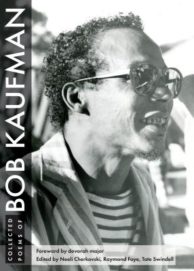 Bob Kaufman
Bob Kaufman
Edited by Neeli Cherkovski, Raymond Foye, and Tate Swindell
City Lights Books ($19.95)
by Christopher Luna
Bob Kaufman will be forever associated with the Beat writers of San Francisco, despite being criminally less lauded than his white contemporaries. As with the best writers, however, there is a great diversity to his thematic and aesthetic concerns, as amply demonstrated in The Collected Poems of Bob Kaufman. The book contains brilliant prose poems such as the epic “Second April,” and sound poems like “Crootey Songo.” “Countess Erika Blaise” mocks the art world’s exploitation of artists by the moneyed class. Kaufman exhibits great wit in “Who Can See the Wind?” and invites the reader to contemplate critical existential questions in “Waiting.”
A great artist is like a mirror: We see ourselves in their work, find places of identification in even the most personal imagery and stories. Kaufman’s work is lush, romantic, and surreal. It is informed by jazz and by love and by the gritty milieu of a post-World War II San Francisco, where he was targeted, harassed, and beaten by police. These poems pay tribute to Ray Charles and Allen Ginsberg and Charlie Parker while also painting a melodic and kaleidoscopic portrait of the American nightmare. They contain a nostalgic melancholy, a hallucinogenic fervor, and a tortured indignation that reflect the chaos and beauty of our country in all its contradictions.
In the tradition of his fellow Beat poets, there is a compassionate spirituality underpinning Kaufman’s criticism of our nation’s failure to live up to its promises. “Night Sailor’s Prayer” ends with a sublime stanza that contrasts sharply with the media’s depiction of the Beat Generation as filthy, hedonistic fools: “Sing love and life and life and love/ All that lives is Holy/ The unholiest, most holy of all.” “Heavy Water Blues” reads as an extended Zen koan which begins and ends with a “radio teaching my goldfish jujitsu” and ends with a series of clever aphorisms:
I never understand other peoples’ desires or hopes,
Until they coincide with my own, then we clash.I have definite proof that the culture of the caveman,
disappeared due to his inability to produce one magazine,
that could be delivered by a kid on a bicycle.When reading all those thick books on the life of god,
It should be noted that they were all written by men.It is perfectly all right to cast the first stone,
If you have some more in your pocket.Television, america’s ultimate relief, from the indian disturbance.
Kaufman’s work embodies the tone and spirit of his patron saints Charlie Parker and Federico Garcia Lorca. In “A Remembered Beat,” Kaufman laments the loss of the legendary saxophonist, “a poet in jazz” who “wore lonely death/ Leaving his breath in a beat.” Lorca’s influence is felt strongly in “The Ancient Rain,” a timeless, powerful poem written by a visionary artist in the tradition of Walt Whitman’s anguished critiques of the nation he loved. While the privileged may have convinced themselves that they had vanquished ignorance and could now rest easy on “post-racial” laurels, the eventual rise of the fascist right-wing racists emboldened by Donald Trump were anticipated by Kaufman in this terrifying poem:
I see the death some cannot see, because I am a poet spread-eagled on this bone of the world. A war is coming, in many forms. It shall take place. The South must hear Lincoln at Gettysburg, the South shall be forced to admit that we have endured. The black son of the American Revolution is not the son of the South. Crispus Attucks’ death does not make him the Black son of the South. Let the voice out of the whirlwind speak:
Federico García Lorca wrote:
Black Man, Black Man, Black Man,
For the mole and the water jet
Stay out of the cleft.
Seek out the great sun
Of the center.
The great sun gliding
over dryads.
The sun that undoes
all the numbers,
Yet never
crossed over a
dream.
As his hero Lorca had done, Kaufman describes walking around Manhattan. He visits Grant’s tomb, and thinks of Lorca’s assassination by “[General Francisco] Franco’s civil guard” in 1936. He is inspired by “Hearing the Lorca music in the endless solitude of crackling blueness. I could feel myself a little boy again in crackling blueness, wanting to do what Lorca says in crackling blueness to kiss out my frenzy on bicycle wheels and smash little squares in the flush of a soiled exultation.”
As with all great poetry, one cannot appreciate the full effect of its musical magic without hearing it in the air. Reading the endless sentence of “Does the Secret Mind Whisper” aloud to myself was a mind-blowing, transformative experience.
This book will be invaluable to students and scholars of post-WWII American poetry. In her foreword, devorah major deems the new collection “a needed compendium” and outlines what is and isn’t “Beat” about Kaufman. This lovingly prepared volume also features photographs, a biographical timeline, remembrances by editors Neeli Cherkovski and Raymond Foye, and uncollected works, several of which appeared in Beatitude, the literary magazine Kaufman started with William J. Margolis in 1959. According to major, Kaufman’s “life is laid out” in his poems, although not always in obviously autobiographical ways. Take some time to immerse yourself in the gorgeous beatitude of this underappreciated American poet-philosopher. This long overdue collection ought to have a lasting impact on all those who believe in the ability of poetry to transform our lives.
